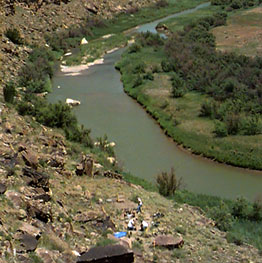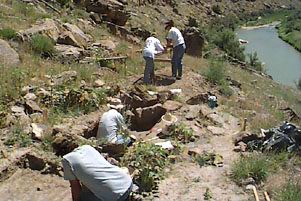|
The Mystery of Ancient America's

Canyon People ViewZone will attempt to give you all the details.
We welcome your comments, analysis and speculations.
Our last stop visits an archaeological "dig" and some exploration of our own. It also leaves us with some impressions.
|
Our last stop takes us nearer to where we began - just outside La Junta. We travel to the side of a canyon bordering the Picket Wire River where a local archaeologist, Bill Tilley, has discovered the likely dwelling of an ancient settlement, one of many that lined the canyons and tributaries of this river.
This particular location overlooks the canyon and surrounding land while providing one of the few level spots to make a dwelling. A large boulder initially attracted Bill Tilley's attention. He later observed black scorch marks on the side of the boulder, suggesting to him that the area had been used as a hearth. Initial excavations revealed a cave under the boulder in which artifacts and charcoal were found. |

|
 | |
In front of the boulder there were buried stones, the tops of which outlines a large circle. about 30 to 40 feet in diameter. With his own funds, Bill Tilley has begun to excavate the earth adjacent to these stones. As suspected, the stones are part of an intact wall that was filled in by earth and all but forgotten for centuries. The current dig is taking the earth away from a portion of this wall to learn how deep it continues and what lies at the bottom.
An dig is plain old hard work. The area must be subjected to measurements, grids plotted with string and of repeated photographs and notes taken as each handful of sand is removed, sifted through a screen and carefully examined. When a curious object is found, the person digging will stop and call for Tilley, who then passes judgment of whether to keep or toss it. Charcoal is carefully collected in aluminum foil so as to preserve the organic integrity for dating. Even some dust or a few cells of our fingers could cause errors in the carbon dating process. Solid artifacts like flint or chips of stone are photographed in place and then placed in numbered bags with accompanying paperwork. All this while the hot sun and thin air make every movement an effort. |
|

